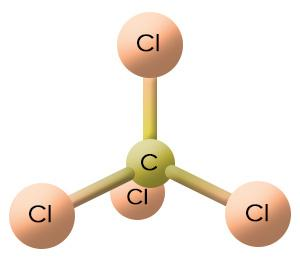Question
Question: The IUPAC name of the \[\text{CC}{{\text{l}}_{\text{4}}}\] is: A. pyrene B. Carbon tetrachloride...
The IUPAC name of the CCl4 is:
A. pyrene
B. Carbon tetrachloride
C. tetrachlorocarbon
D. tetrachloromethane
Solution
Hint: We can find the IUPAC name of CCl4 from the structure, with the help of nomenclature. Once we are able to name the compound from the structure, we can compare it with the options provided.
Complete step-by-step answer:
Below is the structure of CCl4.

From the structure we can see that carbon is the central atom. There are 4 chlorine atoms as the functional groups of the central atom. So, in order to name the compound, we need to consider the position of the chloride atoms, which are 1,1,1,1.
So the IUPAC name of the compound is 1,1,1,1 - tetracholomethane. Here the name is signed as per the position. Here,
Tetra signifies the secondary prefix for four carbon atoms.
Chloro signifies the primary prefix for chlorine.
Meth signifies the root word for carbon number.
Ane signifies the primary suffix for alkane
Therefore, the name is 1,1,1,1 - tetrachloromethane, which can be written as tetrachloromethane. So the correct option is Option D.
Additional Information: We should have a basic idea about the CCl4 compound. Here are some properties of CCl4:
It is a colourless liquid, which has a sweet smell.
The smell can even be detected at low levels.
Most commonly CCl4 is known as Pyrene. It is the industrial name of this compound.
It is used for dry cleaning, degreasing metals, fumigating, and in the manufacture of refrigerants and aerosol propellants.
CCl4 is also used in fire extinguishers because it is heavy non-combustible liquid.
Note: We should know that most commonly CCl4 is known as Pyrene. It is the industrial name of this compound. It has practically no flammability at lower temperatures.
